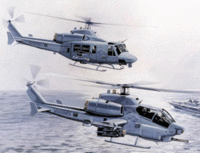Warfare off the Shelf

The US Navy and Marine Corps is planning to purchase 1429 new helicopters in the next few years, mostly updated versions of older designs. Some, like the venerable UH-1 Huey and AH-1 Cobras were originally deployed in Vietnam, but have been updated to be totally unrecognizable to original versions.
To upgrade and standardize the fleet, the Marine Corps plans to replace 183 AH-1W Super Cobras and 86 UH-1N Twin Hueys with 180 AH-1Z attack and 100 UH-1Y armed utility helicopters by 2014. Both new types share four-bladed main and tail rotors, transmissions and twin General Electric turboshafts. The helicopters have infrared engine exhaust suppressors to mask their heat signature and enhance their survivability. The two aircraft share more than 80 percent of identical parts.
New helicopter programs has been severly hindered by the lackluster and overly expensive V-22 Osprey, under development since the early 80's. That said, these fairly cheap and still superb aircraft will be very welcome to our troops flying worn out weapons in Iraq and elsewhere:
Navy program managers contend that the current fleet is wearing out faster than expected as a result of operations in Iraq and Afghanistan. Marine CH-53Es have experienced twice the anticipated attrition resulting from mishaps. Officials predict that airframe fatigue will cause safety problems by 2011 or 2012.
In the first three weeks of Operation Iraqi Freedom, 89 AH-1W attack and 45 UH-1N utility helicopters flew 7,500 hours, an operating tempo several times higher than normal peacetime conditions. The Marines have lost, since 9/11, 17 H-1s, 5.5 percent of the fleet. Their remaining UH-1Ns are underpowered and overweight.


